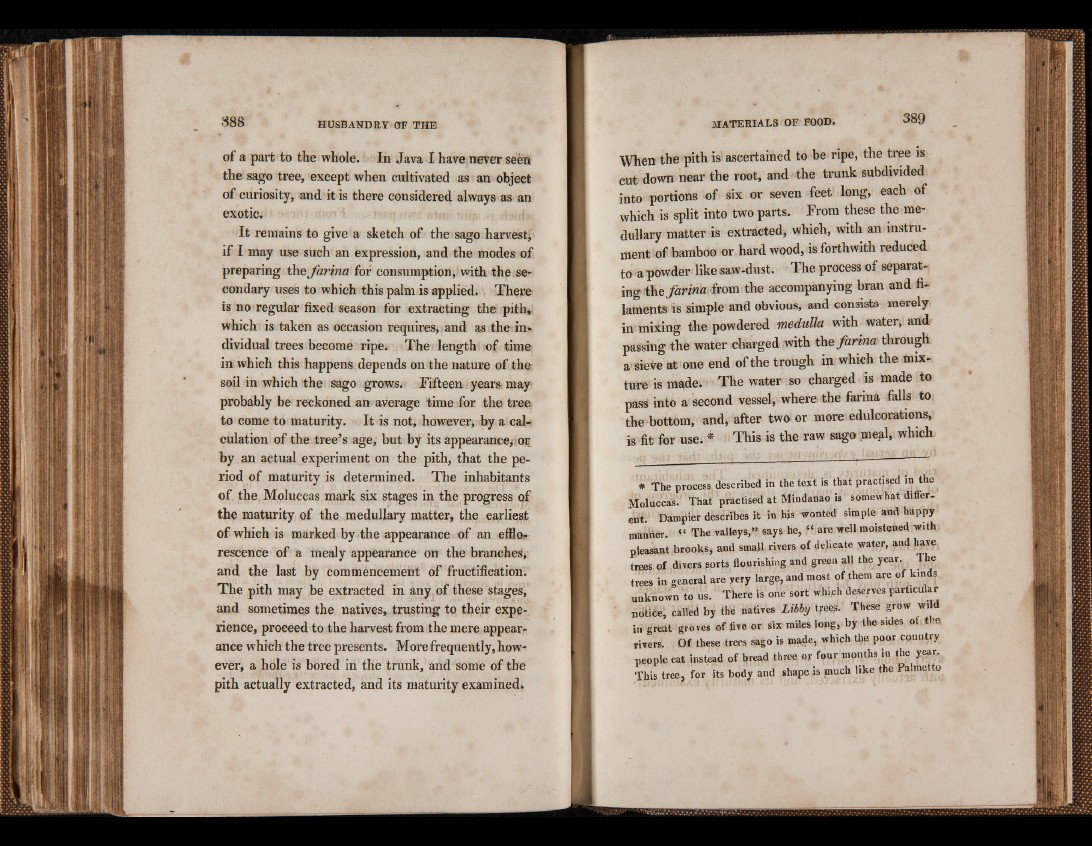
of a part to the whole. In Java I have never seen
the sago tree, except when cultivated as an object
of curiosity, and it is there considered always as an
exotic.
It remains to give a sketch of the sago harvest,
if I may use such an expression, and the modes of
preparing the farina for consumption, with the secondary
uses to which this palm is applied; There
is no regular fixed season for extracting the pith,
which is taken as occasion requires, and as the in»
dividual trees become ripe. The length of time
in which this happens depends on the nature of the
soil in which the sago grows. Fifteen years may
probably be reckoned an average time for the tree
to come to maturity. It is not, however, by a calculation
of the tree’s age, but by its appearance* or
by an aetual experiment on the pith, that the period
of maturity is determined. The inhabitants
of the Moluccas mark six stages in the progress of
the maturity of the medullary matter, the earliest
of which is marked by the appearance of an efflor
rescence of a mealy appearance on the branches*
and the last by commencement of fructification.
The pith may be extracted in any of these stages,
and sometimes the natives, trusting to their experience,
proceed to the harvest from the mere appearance
which the tree presents. More frequently, however,
a hole is bored in the trunk, and some of the
pith actually extracted, and its maturity examined*
When the pith is ascertained to be ripe, the tree is
cut down near the root, and the trunk subdivided
into portions of six or seven feet long, each of
which is split into two parts. From these the medullary
matter is extracted, which, with an instrument
of bamboo or hard wood, is forthwith reduced
to a powder like saw-dust. The process of separating
the farina from the accompanying bran and filaments
is simple and obvious, and consists merely
in’mixing the powdered medulla, with water* and
passing the water charged with the farina through
a sieve at one end of the trough in which the mixture
is made. The water so charged is made to
pass into a second vessel, where the farina falls to
the bottom, and, after two or more edulcorations,
is fit for use. * This is the raw sago meal, which
* The process described in the text is that practised in the
Moluccas. That practised at Mindanao is somewhat different;
Dampier describes it in his wonted simple and happy
mander. » The Talleys,» says h e , a r e well moistened with
pleasant brooks, and small rivers of delicate water, and have
trees of divers sorts flourishing and green all the year. The
trees in general are yery large, and most of them are of kinds ,
unknown to us. There is one sort which deserves particular
notice, called by thé natives Libby trees. These grow wild
in great groves of five or six miles long, by the sides of the
rivers. ,Of these trees sago is made, which the poor country
people eat instead of bread three or four months in fhe year.
This tree, for its body and shape is much like the Palmetto